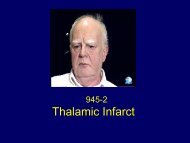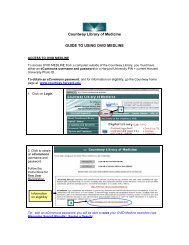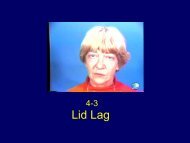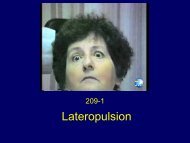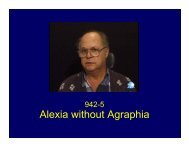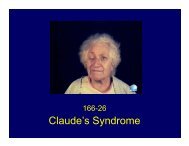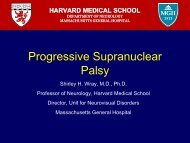affyQCReport: A Package to Generate QC Reports for Affymetrix ...
affyQCReport: A Package to Generate QC Reports for Affymetrix ...
affyQCReport: A Package to Generate QC Reports for Affymetrix ...
You also want an ePaper? Increase the reach of your titles
YUMPU automatically turns print PDFs into web optimized ePapers that Google loves.
<strong>affy<strong>QC</strong>Report</strong>: A <strong>Package</strong> <strong>to</strong> <strong>Generate</strong> <strong>QC</strong> <strong>Reports</strong><br />
<strong>for</strong> <strong>Affymetrix</strong> Array Data<br />
Craig Parman and Conrad Halling<br />
April 30, 2008<br />
Contents<br />
1 Introduction 1<br />
2 Getting Started 2<br />
3 Figure Details 3<br />
3.1 Report page 1 . . . . . . . . . . . . . . . . . . . . . . . . . . . . . . . . . 3<br />
3.2 Report page 2 . . . . . . . . . . . . . . . . . . . . . . . . . . . . . . . . . 3<br />
3.3 Report page 3 . . . . . . . . . . . . . . . . . . . . . . . . . . . . . . . . . 3<br />
3.4 Report page 4 . . . . . . . . . . . . . . . . . . . . . . . . . . . . . . . . . 6<br />
3.5 Report page 5 . . . . . . . . . . . . . . . . . . . . . . . . . . . . . . . . . 6<br />
3.6 Report page 6 . . . . . . . . . . . . . . . . . . . . . . . . . . . . . . . . . 9<br />
1 Introduction<br />
This document describes an R package <strong>for</strong> generating <strong>QC</strong> reports. The goal of this<br />
project is <strong>to</strong> create a <strong>to</strong>ol <strong>to</strong> allow users of the popular <strong>Affymetrix</strong> GeneChip 1 arrays <strong>to</strong><br />
quickly access the data quality of a batch of processed arrays. The package makes use<br />
of the affy Gautier et al. (2004) package <strong>for</strong> reading cell files and generating several of<br />
the plots. The <strong>QC</strong> plot from the package simpleaffy Miller (2005) is also used. Several<br />
new plots are generated and a printable pdf file is created.<br />
The functions in the package will work on normalized or non-normalized data. The<br />
results of these <strong>QC</strong> procedures will change slightly depending on whether normalization<br />
has been done. When in doubt it is recommended that the procedures be run be<strong>for</strong>e<br />
and after normalization.<br />
The example data included in the affydata package can be used <strong>to</strong> generate a example<br />
report.<br />
1 www.affymetrix.com/<br />
1
2 Getting Started<br />
After starting R, the package should be loaded using the following.<br />
> library(<strong>affy<strong>QC</strong>Report</strong>)<br />
This will load <strong>affy<strong>QC</strong>Report</strong> as well as the affy and simpleaffy packages and their<br />
dependencies. The example data named Dilution which is an object of class AffyBatch<br />
his loaded with the following data command.<br />
> library(affydata)<br />
> data(Dilution)<br />
To generate an example report simply use the method <strong>QC</strong>Report<br />
R> <strong>QC</strong>Report(Dilution,file="Example<strong>QC</strong>.pdf")<br />
Any valid AffyBatch object can be used as long as the corresponding CDF environment<br />
is also available. Phenotypic data contained in the AffyBatch object will be used<br />
<strong>to</strong> group arrays, but it is not required. If the AffyBatch object needs <strong>to</strong> be created from<br />
the cel files, a call directly <strong>to</strong> the various <strong>for</strong>ms of the ReadAffy method can be used.<br />
For example the graphical user interface widget can be used <strong>for</strong> input as shown below.<br />
R> <strong>QC</strong>Report(ReadAffy(widget=TRUE))<br />
The methods <strong>for</strong> creating AffyBatch objects are described further in the affy package<br />
documentation.<br />
The report consists of 6 pages. The first page consists of a list of the sample names<br />
and an index number that is used <strong>to</strong> identify each array in later plots. The second page<br />
consists of two plots made using the affy package. The first is a box plot of the pm<br />
intensities and the second plot consists of density plot of the log these intensities. The<br />
third page is the <strong>QC</strong> plot generated with the simpleaffy package. This plot shows the<br />
3 ′ : 5 ′ ratios <strong>for</strong> spiked-in and control genes specific <strong>to</strong> the array type. Additionally the<br />
percentages of present gene calls and background levels are given.<br />
The next two pages are generated by analyzing the intensities of the positive and<br />
negative control elements on the outer edges of the <strong>Affymetrix</strong> arrays. The fourth page<br />
contains box plots of the intensities of these positive and negative elements. The fifth<br />
page is a plot of the ”center of intensity” (COI) <strong>for</strong> the positive and negative border<br />
elements. The sixth page is a heat map of the array-array Spearman rank correlation<br />
coefficients of the array intensities. The arrays are ordered using the phenotypic data (if<br />
available) in order <strong>to</strong> place arrays with similar samples adjacent <strong>to</strong> each other. Arrays<br />
of similar expression patterns will have a higher correlation coefficient.<br />
If desired each page can be separately generated by a single function call with the<br />
AffyBatch object as the argument. For example the following command will generate<br />
the titlepage.<br />
R> titlePage(Dilution)<br />
2
3 Figure Details<br />
This section will describe the details of each page of the report and the function call <strong>to</strong><br />
generate the individual pages. An expample of each page is shown in a figure.<br />
3.1 Report page 1<br />
The first page simple list the names of the arrays and assigns an index number <strong>to</strong> be<br />
used in future plotting. The names taken from the data set by use of the sampleNames<br />
method of the affy package. These sample names and indexes are also listed on several<br />
other plots. An example is shown in Fig. 1. The plot is generated with the following<br />
command.<br />
R> titlePage(Dilution)<br />
3.2 Report page 2<br />
The second page consists of two plots. The first is a boxplot plot of the all pm intensities<br />
and the second plot consists of kernel density estimates of these intensities. Both of these<br />
methods are defined in the affy package. These plots are useful assessing the overall<br />
signal quality <strong>for</strong> the arrays. Any array with a low average intensity or a significantly<br />
different shaped density would be suspect. An example is shown in Fig. 2. The plot is<br />
generated with the following command.<br />
R> signalDist(Dilution)<br />
3.3 Report page 3<br />
The third page is the <strong>QC</strong> plot from the simpleaffy package. This plot shows the 3 ′ : 5 ′<br />
ratio <strong>for</strong> spiked-in and control genes specific <strong>to</strong> the array type. Additionally the percentage<br />
of present gene calls and background levels are given. An example is shown in Fig.<br />
3.The plot is described in detail in the document <strong>QC</strong> and <strong>Affymetrix</strong> data included in the<br />
simpleaffy documentation. The following is an excerpt from that document describing<br />
the plot.<br />
The figure is plotted from the bot<strong>to</strong>m up with the first chip being at the<br />
base of the diagram and the last chip in the <strong>QC</strong>Stats object at the <strong>to</strong>p. If<br />
the standard steps <strong>for</strong> generating a <strong>QC</strong>Stats object are followed, then this<br />
corresponds <strong>to</strong> the order of your samples in the AffyBatch object. Dotted<br />
horizontal lines separate the plot in<strong>to</strong> rows, one <strong>for</strong> each chip. Dotted vertical<br />
lines provide a scale from -3 <strong>to</strong> 3. Each row shows the %present, average<br />
background, scale fac<strong>to</strong>rs and GAPDH / β-actin ratios <strong>for</strong> an individual<br />
chip.<br />
3
AffyBatch <strong>QC</strong> Report<br />
Array Index<br />
Array Name<br />
1 20A<br />
2 20B<br />
3 10A<br />
4 10B<br />
Wed Apr 30 02:21:21 2008<br />
Produced by Affy<strong>QC</strong>Report R <strong>Package</strong><br />
Figure 1:<br />
First page: Table of arrays in the data set.<br />
4
Small part of dilution study<br />
Log2(Intensity)<br />
6 8 12<br />
1 2 3 4<br />
Array Index<br />
density<br />
0.0 0.4 0.8<br />
1<br />
2<br />
3<br />
4<br />
6 8 10 12 14<br />
log intensity<br />
Figure 2:<br />
Second page: Boxplot and his<strong>to</strong>grams of pm intensities.<br />
5
ˆ GAPDH 3 ′ : 5 ′ values are plotted as circles. According <strong>to</strong> <strong>Affymetrix</strong><br />
they should be about 1. GAPDH values that are considered potential<br />
outlier (ratio > 1.25) are coloured red, otherwise they are blue.<br />
ˆ β-actin, 3 ′ : 5 ′ ratios are plotted as triangles. Because this is a longer<br />
gene, the recommendation is <strong>for</strong> the 3 ′ : 5 ′ ratios <strong>to</strong> be below 3; values<br />
below 3 are coloured blue, those above, red.<br />
ˆ The blue stripe in the image represents the range where scale fac<strong>to</strong>rs<br />
are within 3-fold of the mean <strong>for</strong> all chips. Scale fac<strong>to</strong>rs are plotted as<br />
a line from the centre line of the image. A line <strong>to</strong> the left corresponds<br />
<strong>to</strong> a down-scaling, <strong>to</strong> the right, <strong>to</strong> an up-scaling. If any scale fac<strong>to</strong>rs fall<br />
outside this Ś3-fold regionŠ, they are all coloured red, otherwise they<br />
are blue.<br />
ˆ % present and average background, are listed <strong>to</strong> left of the figure.<br />
The plot is generated with the following command.<br />
R> plot(qc(Dilution))<br />
3.4 Report page 4<br />
The next two pages are generated by analyzing the positive and negative control elements<br />
on the outer edges of the <strong>Affymetrix</strong> arrays. For each array the intensities <strong>for</strong> all border<br />
elements are collected. Elements with an intensity greater the 1.2 times the mean <strong>for</strong><br />
that group are assumed <strong>to</strong> be positive controls. Elements with a signal less that 0.8 of the<br />
mean are assumed <strong>to</strong> be negative controls. This method of separation in<strong>to</strong> positive and<br />
negative controls is used so that exact details of the arrangement of these elements is not<br />
required. Elements falling in between these cut offs are not used in further calculations.<br />
The fourth page consists of box plots of the positive and negative elements. The<br />
means and standard deviations of the intensities <strong>for</strong> each array should be comparable.<br />
Large variations in the positive control can indicate non-uni<strong>for</strong>m hybridization or gridding<br />
problems. Variations in the negative controls indicate background fluctuations.<br />
The plot (shown in Fig. 4) is generated with the following command.<br />
R> border<strong>QC</strong>1(Dilution)<br />
3.5 Report page 5<br />
As a further test, the elements are separated based on which edge of the array they are<br />
located. The mean values <strong>for</strong> the left, right, <strong>to</strong>p, and bot<strong>to</strong>m elements are calculated<br />
<strong>for</strong> positive and negative controls. Once the elements are separated in<strong>to</strong> positive and<br />
6
Figure 3:<br />
Third page: simpleaffy <strong>QC</strong> plot of 3 ′ : 5 ′ ratios and percent present calls.<br />
7
●<br />
Positive Border Elements<br />
Negative Border Elements<br />
Intensity<br />
200 400 600 800 1000 1200 1400<br />
●<br />
●<br />
●<br />
●<br />
●<br />
●<br />
●<br />
●<br />
●<br />
●<br />
●<br />
●<br />
Intensity<br />
100 200 300 400 500<br />
●<br />
●<br />
●<br />
●<br />
●<br />
●<br />
●<br />
●<br />
●<br />
●<br />
●<br />
●<br />
●<br />
●<br />
●<br />
●<br />
●<br />
●<br />
●<br />
●<br />
●<br />
●<br />
●<br />
●<br />
●<br />
●<br />
●<br />
●<br />
●<br />
●<br />
●<br />
●<br />
●<br />
1 2 3 4<br />
Array Index<br />
1 2 3 4<br />
Array Index<br />
Sample Name<br />
20A 20B 10A 10B<br />
1 2 3 4<br />
Array Index<br />
Figure 4:<br />
Fourth page: Boxplot of positive and negative feature intensities.<br />
8
negative controls, and further divided by the four locations, the ”center of intensity”<br />
(COI) <strong>for</strong> the controls is calculated. If the hybridization is uni<strong>for</strong>m across the array,<br />
the location the COI <strong>for</strong> the positive elements will be located at the physical center of<br />
the array. Any spatial variations in the hybridization, such as those caused by a bubble<br />
being present during hybridization, will cause the COI <strong>to</strong> move from center. Another<br />
cause <strong>to</strong> the COI being off center is a slight misalignment of the grid used <strong>to</strong> determine<br />
the cell intensities.<br />
The COI is plotted on a relative scale where the point (0,0) is the center and 1<br />
and -1 represent the edges of the array. Some variation <strong>to</strong> the COI is expected but an<br />
array with visible intensity variations stands out in these plots as an outlier. Any array<br />
that where the COI has coordinate with and magnitude greater that 0.5 is flagged by<br />
labeling the data point with the array index.<br />
A similar plot is made <strong>for</strong> the negative controls. This plot is a measure of the uni<strong>for</strong>mity<br />
of the background across the array. Again arrays where the COI has coordinate<br />
with and magnitude greater that 0.5 is flagged. An example is shown in Fig. 5. The<br />
plot is generated with the following command.<br />
R> border<strong>QC</strong>2(Dilution)<br />
3.6 Report page 6<br />
The sixth page is a heat map of the array-array Spearman rank correlation coefficients.<br />
The arrays are ordered using the phenotypic data (if available) in order <strong>to</strong> place arrays<br />
with similar samples adjacent <strong>to</strong> each other. Self-self correlations are on the diagonal<br />
and by definition have a correlation coefficient of 1.0. Data from similar tissues or<br />
treatments will tend <strong>to</strong> have higher coefficients. This plot is useful <strong>for</strong> detecting outliers,<br />
failed hybridizations, or mistracked samples. See in Fig. 6 <strong>for</strong> an exaple. Of course<br />
caution must be used in deciding if an array should be discarded, because the differences<br />
in the expression patterns might be due <strong>to</strong> interesting biology, not a processing error.<br />
The plot is generated with the following command.<br />
R> correlationPlot(Dilution)<br />
9
Positive Elements<br />
Negative Elements<br />
Y Center of Intensity position<br />
−1.0 −0.5 0.0 0.5 1.0<br />
●<br />
●<br />
● ●<br />
Y Center of Intensity position<br />
−1.0 −0.5 0.0 0.5 1.0<br />
●<br />
●<br />
● ●<br />
−1.0 −0.5 0.0 0.5 1.0<br />
−1.0 −0.5 0.0 0.5 1.0<br />
X Center of Intensity position<br />
X Center of Intensity position<br />
Sample Name<br />
20A 20B 10A 10B<br />
1 2 3 4<br />
Array Index<br />
Figure 5: Fifth page: ”Center of intensity” <strong>for</strong> positive and negative feature intensities.<br />
10
Array−Array Intensity Correlation<br />
Array Index<br />
3 4 1 2<br />
Correlation Coefficient<br />
0.96 0.965 0.97 0.975 0.98 0.985 0.99 0.995 1<br />
3 4 1 2<br />
Array Index<br />
1 2 1 2<br />
0 0 0 0<br />
10 10 20 20<br />
2.5<br />
1.5<br />
0.5<br />
3 4 1 2<br />
Array Index<br />
Figure 6:<br />
Sixth page: Array-array Spearman rank correlation coefficients<br />
11
References<br />
Laurent Gautier, Leslie Cope, Benjamin M. Bolstad, and Rafael A. Irizarry. affy–analysis<br />
of <strong>Affymetrix</strong> GeneChip data at the probe level. Bioin<strong>for</strong>matics, 20(3):307–315, 2004.<br />
http://bioin<strong>for</strong>matics.oupjournals.org/cgi/content/abstract/20/3/307.<br />
Crispin J Miller. simpleaffy, 2005. http://bioin<strong>for</strong>matics.picr.man.ac.uk/simpleaffy/index.jsp.<br />
12






